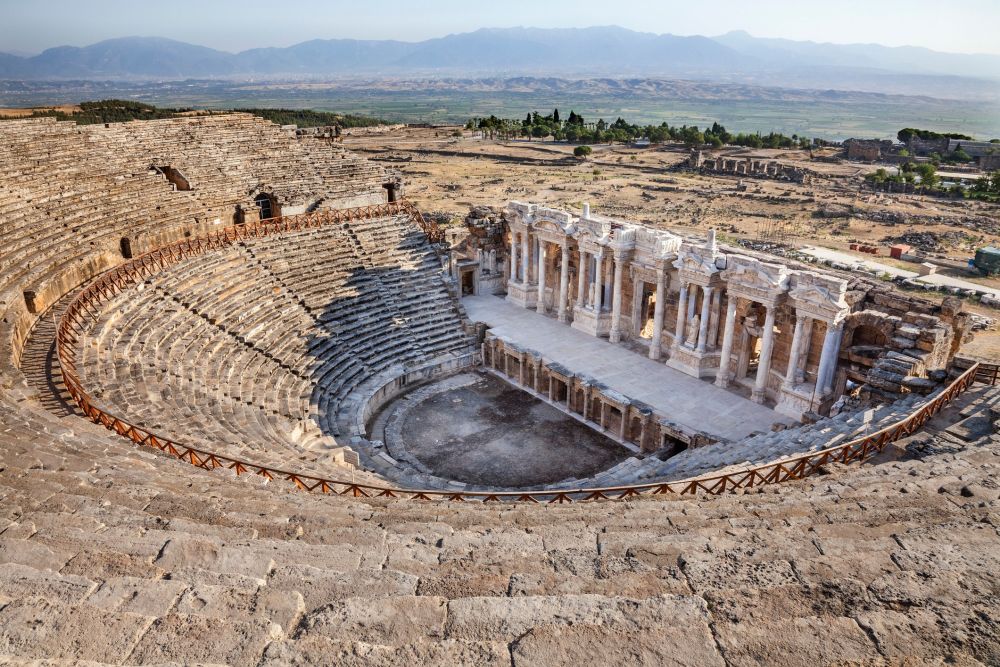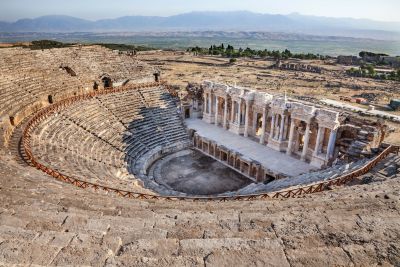

Step back in time with a guided tour of the Hierapolis Archaeological Site, a UNESCO World Heritage location nestled above the stunning white terraces of Pamukkale. Hierapolis, an ancient Greco-Roman city, offers a unique glimpse into the past with its well-preserved theater, monumental fountain, Temple of Apollo, and the extensive necropolis. Strolling through the ancient streets, you will learn about the rich history and cultural significance of the area. Discover the tales behind the ruins and find out how this city fused Greek culture with Eastern traditions. Visitors have the rare chance to walk through the Roman baths and imagine the social life around the sacred pool. Don't forget to capture stunning photos of the surrounding landscape from the vantage points around the site.
Indulge in a unique swimming experience at Hierapolis's Antique Pool, also known as Cleopatra’s Pool, where you can soak in warm, mineral-rich waters amidst ancient Roman ruins. According to legend, the pool was a gift from Mark Antony to Cleopatra. Earthquakes have toppled marble columns into the water, creating an enchanting environment. The thermal waters, believed to have healing properties, are a perfect way to relax and rejuvenate after exploring the ruins. The site is equipped with modern facilities, ensuring a comfortable and memorable dip in this historic pool. Whether you're a history buff or simply seeking relaxation, the Antique Pool offers a surreal and luxurious escape.
The Pamukkale Terraces Walk is an astounding natural wonder adjacent to Hierapolis. Known as 'Cotton Castle' in Turkish, Pamukkale is famous for its ethereal white travertine terraces filled with mineral-rich thermal waters. Visitors can meander along the designated pathways, feeling the travertine beneath their bare feet – shoes must be removed to protect the formations. The terraces offer breathtaking views and a surreal landscape that makes for an unforgettable experience. As you wade through shallow, warm pools, be sure to enjoy the panoramic views of the surrounding valley. Remember to capture pictures during different times of the day, as the sunlight shifts and illuminates the terraces in various hues.
A visit to the Hierapolis Museum is a must for history enthusiasts and those keen to delve deeper into the area's cultural legacy. Housed in the former Roman Bath complex, the museum presents an extensive collection of artifacts, reliefs, and sculptures unearthed from Hierapolis and its surroundings. The exhibitions include items from the Bronze Age up to the Byzantine period, offering insights into the lives and beliefs of the ancient inhabitants. The museum's well-curated displays provide a narrative to your exploration of the ruints outside, enabling a connection to the day-to-day lives of the civilizations that once thrived here.
Witness the grandeur of the ancient world with a live performance at Hierapolis Theatre. Originally built during the Hellenistic period, the theatre was expanded by the Romans to accommodate up to 15,000 spectators. Today, it remains a defining feature of the archaeological site and provides a stunning backdrop for classical dramas, concerts, and cultural events. Enjoying a performance in this historical setting is an immersive way to experience the acoustics and atmosphere that ancient patrons once enjoyed. The events vary by season, so visitors should check the local event schedule upon arrival.
Explore one of the most extensive ancient cemeteries on a guided necropolis visit in Hierapolis. The vast burial ground with its array of tombs, sarcophagi, and monumental graves reflects the city's historical importance and diverse cultural influences over the centuries. A knowledgeable guide will lead you through the labyrinthine paths, sharing captivating stories about burial traditions, notable residents, and the significance of funerary art. The necropolis at Hierapolis is a testament to the ancient city's wealth and cultural diversity, providing a poignant reminder of the inhabitants who once walked the streets of this thriving metropolis.
Experience the magic of a Pamukkale sunset, where the calcite-laden waters and the travertine terraces reflect the changing colors of the sky. As the sun dips below the horizon, the terraces glow with hues of pink, orange, and purple. This tranquil moment allows for contemplation and appreciation of nature's beauty. It's a popular time for visitors, so arrive early to find a peaceful spot. Many find this time of day ideal for photography, as the soft, golden light enhances the natural splendor of the terraces. For the romantics and the photographers alike, sunset at Pamukkale is an event that should not be missed.
Take to the skies for the ultimate view of Pamukkale and Hierapolis with a hot air balloon ride at dawn. Drift silently over the unique travertine terraces and ancient ruins as the sun rises, revealing the full splendor of the site. This perspective offers unmatched photo opportunities and lifelong memories. The calm of the early morning and the panoramic views of the landscape make for a serene and thrilling adventure. Professionals pilot the balloons, assuring a safe and enjoyable journey. Most balloon rides include a celebratory toast upon landing and a commemorative flight certificate.
Delve into the architecture and history of Hierapolis by visiting the Roman Amphitheatre, one of the most magnificent and well-preserved landmarks of the site. With a capacity of over 12,000 spectators, this ancient theatre showcases the sophisticated design and engineering skills of the Romans. As you climb up the steep seating rows, you'll gain a marvelously unobstructed view of the stage and skene, where gladiators once clashed and actors performed epic dramas. The theatre also offers insights into the social structure of Hierapolis, as the seating arrangements reflect the hierarchical order of the Roman society. Signboards with historical information enhance the self-guided exploration of this remarkable edifice.
Beyond the travertine pools and ancient Roman remnants lies a landscape rich in natural beauty. Visitors to Pamukkale can venture on a nature walk to explore nearby paths and enjoy the native flora and fauna. While the main attractions are undoubtedly the terraces and ruins of Hierapolis, these lesser-known trails offer a peaceful reprieve from the bustling tourist areas. Take time to observe the local wildlife, discover hidden spots with fewer crowds, and appreciate the valley's stunning geology. Such walks are perfect for those looking for a tranquil experience and the chance to appreciate the serenity of this unique region.
